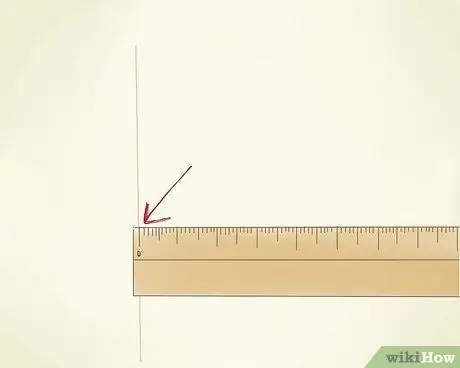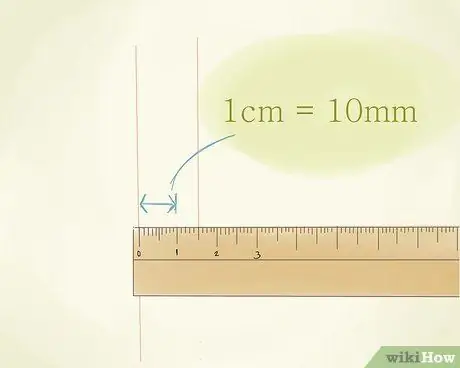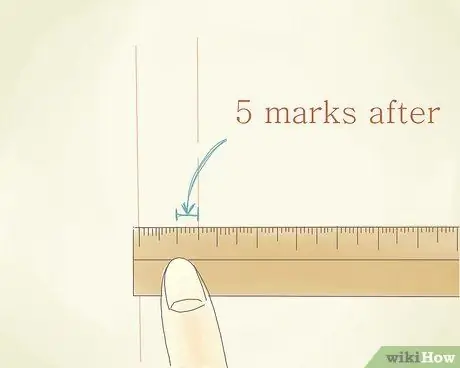You will usually use a ruler or tape measure to make measurements in millimeters. If you don't have one, there are also methods for estimating a length in millimeters. Similarly, if you have a measurement expressed in another unit of length, you can convert that measurement to the equivalent value in millimeters.
Steps
Method 1 of 4: Method One: Take a Measurement in Millimeters

Step 1. Look at the unnumbered lines on a ruler
Numbered lines represent centimeters, while unnumbered lines represent millimeters.
- If the ruler is too short, you can use a tape measure. The small unnumbered lines on the tape measure, which are between the numbered lines, represent millimeters.
- Note that 1 cm equals 10 mm.

Step 2. Match the “0” on the ruler with the leading edge of what you need to measure
Position the ruler so that the “0” is aligned and parallel to the starting point of what you want to measure.
The ruler may not have "0" written. In this case, know that the "0" coincides with the dash that comes immediately before the number "1" marked on the ruler

Step 3. Read the number marked immediately before the end of the object you are measuring
Find where the edge or line you are measuring ends. Find the number of centimeters just before that point and multiply it by 10 to determine how many millimeters it equals.
- Keep the ruler flat and parallel to the side of the object being measured.
-
If the border or line ends exactly on a numbered line, you just need to multiply this value by 10 to get the final answer.
Example: the length of a line measures from 0 to the line with the 2, so the line is 20 (2 x 10) mm long

Step 4. Count the unnumbered lines after the last number marked
Count the number of millimeter lines between the last marked number you just found and the end point of what you need to measure.

Step 5. Add the two values obtained to calculate the length in millimeters
The sum of the converted centimeter value and the millimeter value just found equals the measurement in millimeters of the length of what you need to measure.
-
Example: a line extends from 0 to the fifth line after the number 7, so its length is 75 mm.
- 7 x 10 = 70
- 70 + 5 = 75
Method 2 of 4: Method Two: Estimate Millimeters

Measure Mm Step 6 Step 1. Find an object that measures approximately 1 millimeter
The easiest items to use are a laminated ID card, a laminated driving license, a credit card, or a library card. Such laminated cards usually have a thickness of about 1 millimeter.
These are the easiest items to use. Other objects about 1 millimeter in length or width are more difficult to use, but may include a grain of salt or sand, 10 sheets of a notepad joined together, the thickness of a sheet of thick paper, the thickness of a fingernail, a grain of rice or a euro cent

Measure Mm Step 7 Step 2. Put the object to be measured on a sheet of paper
Place the object on a sheet of white or light-colored paper. Make sure the whole object fits on the paper.
- If you want, you can draw the edge of the object to be measured with a pencil. So you will be able to remove the object and work with only a straight line, which makes it easier to take measurements of such small lengths. However, doing so is optional.
- The card must be clear, so that you can clearly see the marks made.

Measure Mm Step 8 Step 3. Mark the starting point
Use a pencil to draw a straight line across one of the starting points of what you are measuring. This will be the starting point.

Measure Mm Step 9 Step 4. Put the object you are measuring against the edge you want to start from
Align one edge of the laminated card with the edge of the object to be measured. Make a dot on the opposite side of the tile.
- The mark you make should be as close to the edge of the paper as possible.
- Note that you can use this method with any other object you decide to use as an estimate measure. It is not exclusive to the plastic card.

Measure Mm Step 10 Step 5. Move the object used to measure
Take it and reposition it so that its side matches the mark you just made. Make another mark on the opposite side. Keep moving the tile like this, making a mark each time, until you reach the end point of what you are measuring.
- Make sure the object you use to measure remains perpendicular to the other every time you move it.
- Make sure that the end point of the object you are measuring is also marked.

Measure Mm Step 11 Step 6. Count the spaces
When you are done, remove all the objects from the paper. Count the number of spaces between the marks you made. This number corresponds to the estimate of the measurement in millimeters of the object.
Count the spaces. You have to count the spaces, not the signs
Method 3 of 4: Method Three: Convert other Length Units to Millimeters

Measure Mm Step 12 Step 1. Convert centimeters to millimeters
There are 10 millimeters in 1 centimeter.
- If you know the length of an object in centimeters, but you need it in millimeters, multiply the number of centimeters by 10.
- Example: 2, 4 cm x 10 = 24 mm

Measure Mm Step 13 Step 2. Calculate millimeters from meters
1 meter equals 1,000 millimeters.
- If you need to find a length in millimeters but are given a measurement in meters, multiply that measurement by 1,000 to find the equivalent in millimeters.
- Example: 5, 13 m x 1,000 = 5,130 mm

Measure Mm Step 14 Step 3. Determine millimeters from kilometers
1 kilometer equals 1,000,000 millimeters.
- To transform a measurement expressed in kilometers into one in millimeters, you must multiply the value of the kilometers by 1,000,000.
- Example: 1.4 km x 1,000,000 = 1,400,000 mm
Method 4 of 4: Method Four: Convert Anglo-Saxon Measurements to Millimeters

Ace a Math Test Step 4 Step 1. Convert inches to millimeters
If you have a measurement in inches, you can convert it to millimeters by dividing it by the conversion factor 0, 039370.
- There are 25.4mm in 1 inch. However, this value isn't constant, so you'll need a conversion factor instead of adding 25.4mm for every inch.
- Example: 9.3 inches / 0.039370 = 236.22 mm

Be a Good Son Step 9 Step 2. Calculate the millimeters from the feet
To find the millimeter equivalent of a measurement in feet, divide the number of feet by the conversion factor 0, 0032808
Example: 4.7ft / 0.0032808 = 1.432.58mm

Format a Poem Step 5 Step 3. Calculate millimeters from yards
When you have a measurement in yards and you need to convert it to millimeters, you can do it by dividing the value in yards by the conversion factor 0, 0010936






